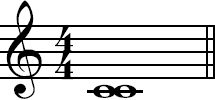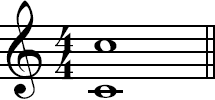Unison and octave intervals
 The unison interval consists of two notes of the same pitch. For example, C and another C note forms a unison interval. On the picture to the right, a unison in musical notation is shown.
The unison interval consists of two notes of the same pitch. For example, C and another C note forms a unison interval. On the picture to the right, a unison in musical notation is shown.
Unison should be distinguished from the octave (see below). While both both are defined by intervals of the same notes, or pitches, the difference is that a unison is an interval with two notes in the same register whereas an octave is the same note but on a different register.


Unison in C and Octave C.
Listen to the unison interval (C-C):
Unison is also referred to as a perfect unison and is abbreviated P1. The number derives from the fact that the unison is the first interval, with no distance between notes. An alternate naming is diminished second.
To recognize this interval by ear, try to think of a familiar song whose first two notes match it. "Scarborough Fair" (D-D) is one of many such songs. The song "Somewhere Over the Rainbow" uses an octave in the first two notes.
Examples of unison intervals
Listing unison intervals is rather superfluous, but to make it extra clear, here are all possible unisons:
- C – C
- C#/Db – C#/Db
- D – D
- D#/Eb – D#/Eb
- E – E
- F – F
- F#/Gb – F#/Gb
- G – G
- G#/Ab – G#/Ab
- A – A
- A#/Bb – A#/Bb
- B – B
Enharmonic notes such as Cb and Fb are omitted.
Octave
 A related interval is the octave, which includes the same notes as the unison but at a different pitch. For example, C and C in the next octave. This could be written out as C4 and C5, meaning C notes in the fourth and the fifth octaves respectively.
A related interval is the octave, which includes the same notes as the unison but at a different pitch. For example, C and C in the next octave. This could be written out as C4 and C5, meaning C notes in the fourth and the fifth octaves respectively.
Listen to the octave interval (C1-C2):
The octave is also referred to as a perfect octave and is abbreviated P8. The number derives from the fact that the distance between the notes is eight scale steps. If all notes (half-steps) are counted the distance is twelve notes. An alternate naming is augmented seventh.